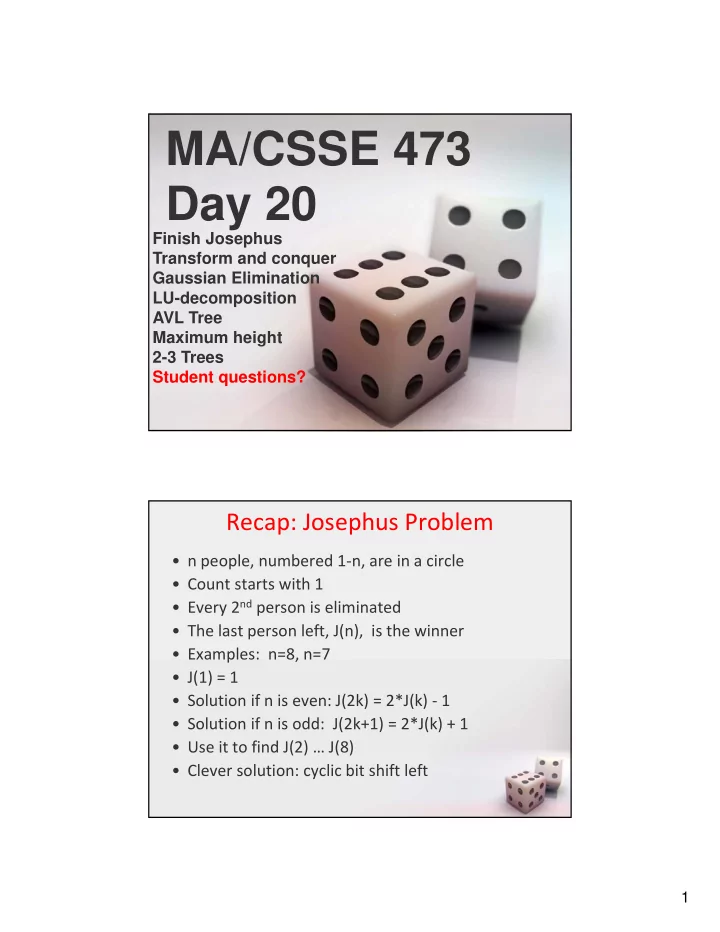

MA/CSSE 473 Day 20 Finish Josephus Transform and conquer Gaussian Elimination LU-decomposition AVL Tree Maximum height 2-3 Trees Student questions? Recap: Josephus Problem • n people, numbered 1 ‐ n, are in a circle • Count starts with 1 • Every 2 nd person is eliminated • The last person left, J(n), is the winner • Examples: n=8, n=7 • J(1) = 1 • Solution if n is even: J(2k) = 2*J(k) ‐ 1 • Solution if n is odd: J(2k+1) = 2*J(k) + 1 • Use it to find J(2) … J(8) • Clever solution: cyclic bit shift left 1
Transform and Conquer Algorithms • Transform a problem to a simpler instance of the same problem – instance simplification • Transformation to a different representation of the same instance – representation change • Transformation to an instance of a different problem that we know how to solve – problem reduction Instance simplification: Presorting an Array • The following problems are simplified by pre ‐ sorting the array: – Search (can do Binary or Interpolation search) – Determine whether the array contains duplicates – Find the median of the array – Find the mode of the elements of the array • The most frequently ‐ occurring element – A related problem: Anagrams • In a large collection of words, find words that are anagrams of each other • How can pre ‐ sorting help? • Sort the letters of each word – Interval union problem from early part of PLC course 2
Instance Simplification: Gaussian Elimination (hopefully you saw basics in a DE or lin. Alg. course) • Solve a system of n linear equations in n unknowns – Represent the system by an augmented coefficient matrix – Transform the matrix to triangular matrix by a combination of the following solution ‐ preserving elementary operations: • exchange two rows • multiply a row by a nonzero constant • replace a row by that row plus or minus a constant multiple of a different row – Look at the algorithm and analysis on pp 207 ‐ 208; if you can't understand them, ask in my office. – Ѳ (n 3 ) [previous HW problem] Other Applications of G.E. • Matrix inverse – Augment a square matrix by the identity matrix – Perform elementary operations until the original matrix is the identity. – The "augmented part" will be the inverse – More details and an example at http://en.wikipedia.org/wiki/Gauss ‐ Jordan_elimination 3
Other Applications of G.E. • Determinant calculation – Calculation of the determinant of a triangular matrix is easy • What effect does each of the elementary operations have on the determinant value? – exchange two rows – multiply a row by a nonzero constant – replace a row by that row plus or minus a constant multiple of a different row • Do these operations until you get a triangular matrix • Keep track of the operations' cumulative effect on the determinant LU Decomposition • This can speed up all three applications of Gaussian Elimination • Write the matrix A as a product of a Lower Triangular matrix L and an upper Triangular matrix U. 25 5 1 Splitting A up into L and U is an n 3 operation. A 64 8 1 • Example: https://rosettacode.org/wiki /LU_decomposition 144 12 1 1 0 0 25 5 1 L 2 . 56 1 0 U 0 4 . 8 1 . 56 5 . 76 3 . 5 1 0 0 0 . 7 4
Review: Representation change: AVL Trees (what you should remember…) • Named for authors of original paper, A delson ‐ V elskii and L andis (1962). • An AVL tree is a height ‐ balanced Binary Search Tree. • A BST T is height balanced if T is empty, or if – | height( T L ) ‐ height( T R ) | 1, and – T L and T R are both height ‐ balanced. • Show: Maximum height of an AVL tree with N nodes is (log N) Let's review that together • How do we maintain balance after insertion? • Exercise for later: Given a pointer to the root of an AVL tree with N nodes, find the height of the tree in log N time • Details on balance codes and various rotations are in the CSSE 230 slides that are linked from the schedule page. Representation change: 2 ‐ 3 trees • Another approach to balanced trees • Keeps all leaves on the same level • Some non ‐ leaf nodes have 2 keys and 3 subtrees • Others are regular binary nodes. 5
2 ‐ 3 tree insertion example • More examples of insertion: http://www.cs.ucr.edu/cs14/cs14_06win/slides/2 ‐ 3_trees_covered.pdf http://slady.net/java/bt/view.php?w=450&h=300 Add 10, 11, 12, … to the last tree Efficiency of 2 ‐ 3 tree insertion • Upper and lower bounds on height of a tree with n elements? • Worst case insertion and lookup times is proportional to the height of the tree. 6
2 ‐ 3 Tree insertion practice • Insert 84 into this tree and show the resulting tree 7
Recommend
More recommend